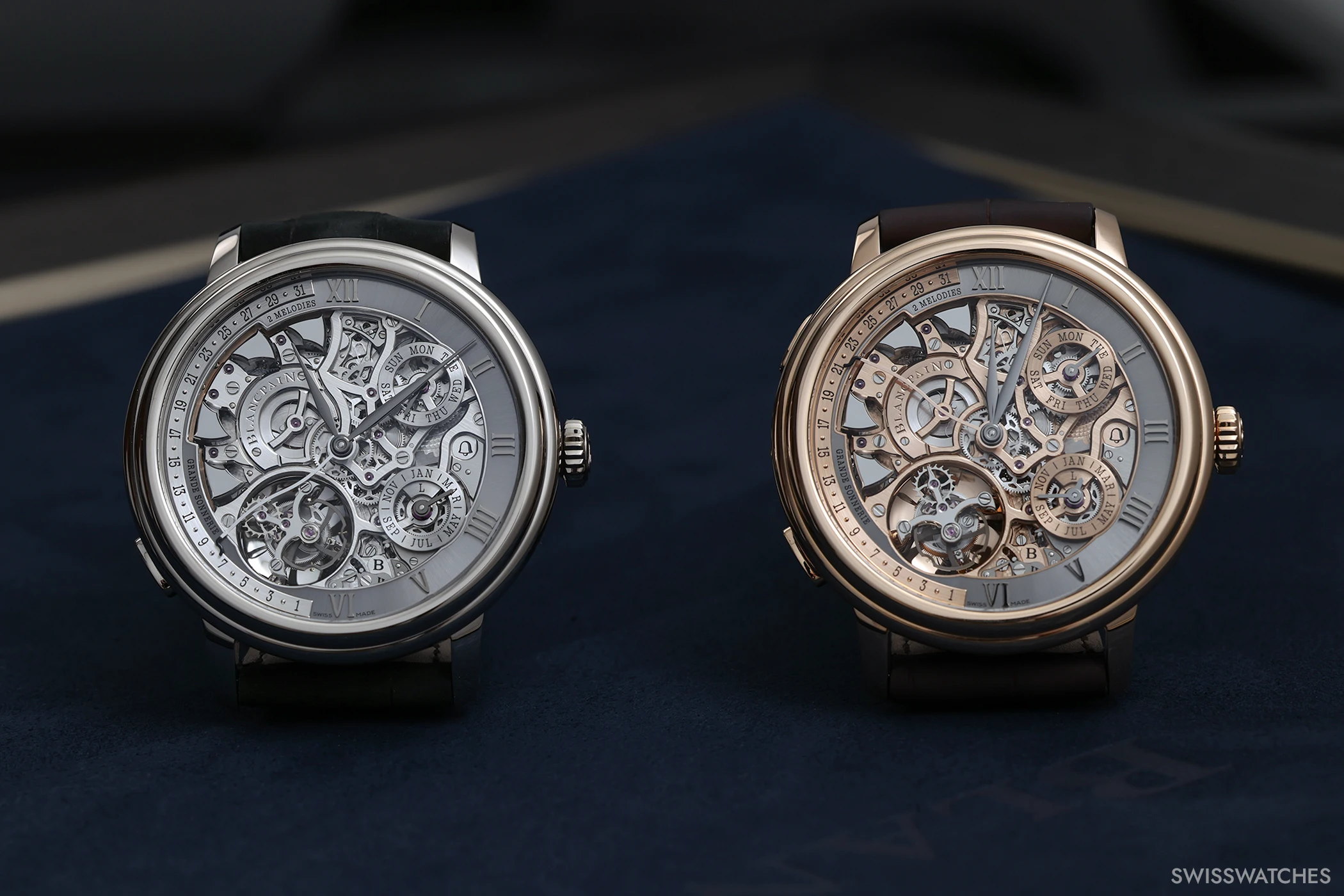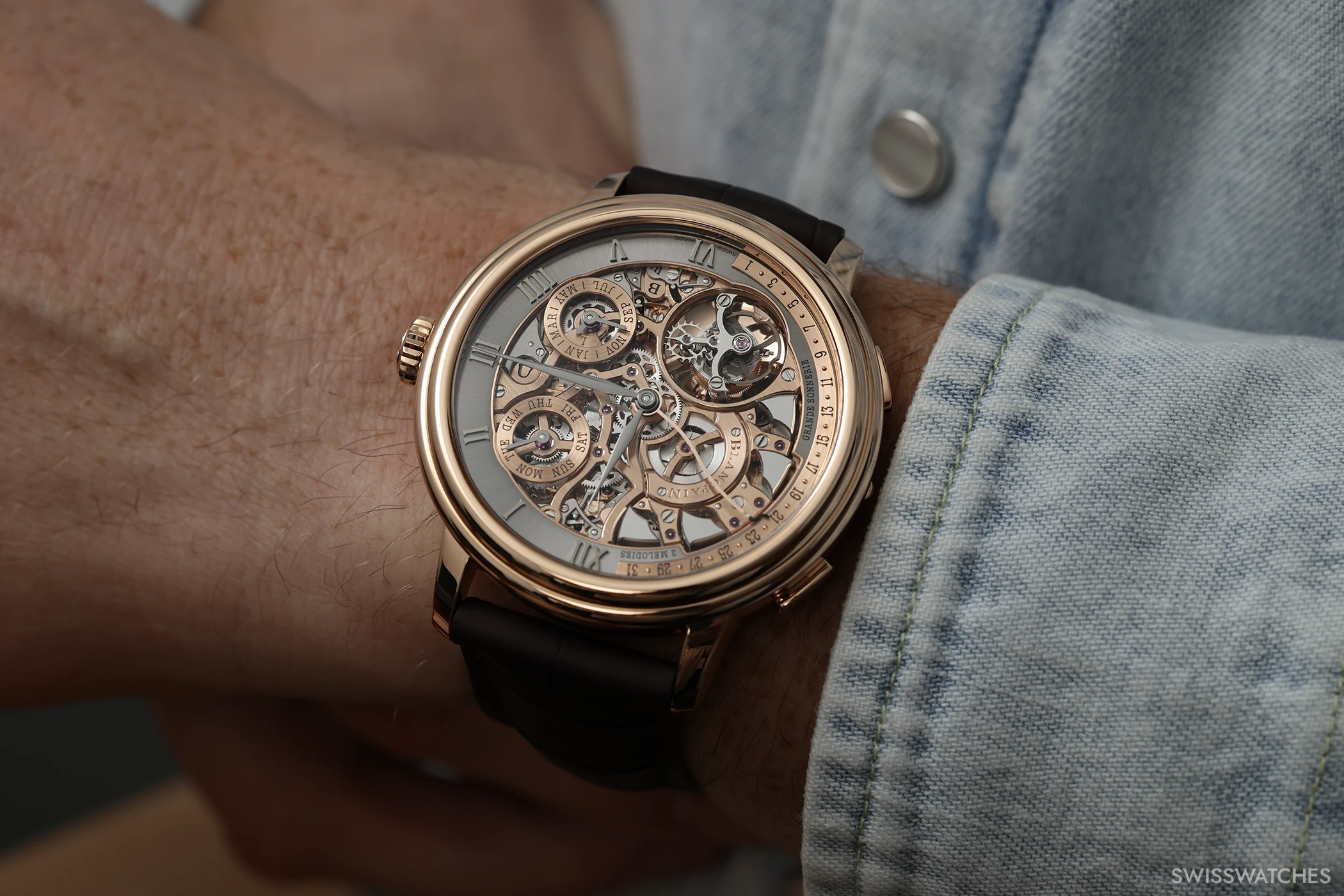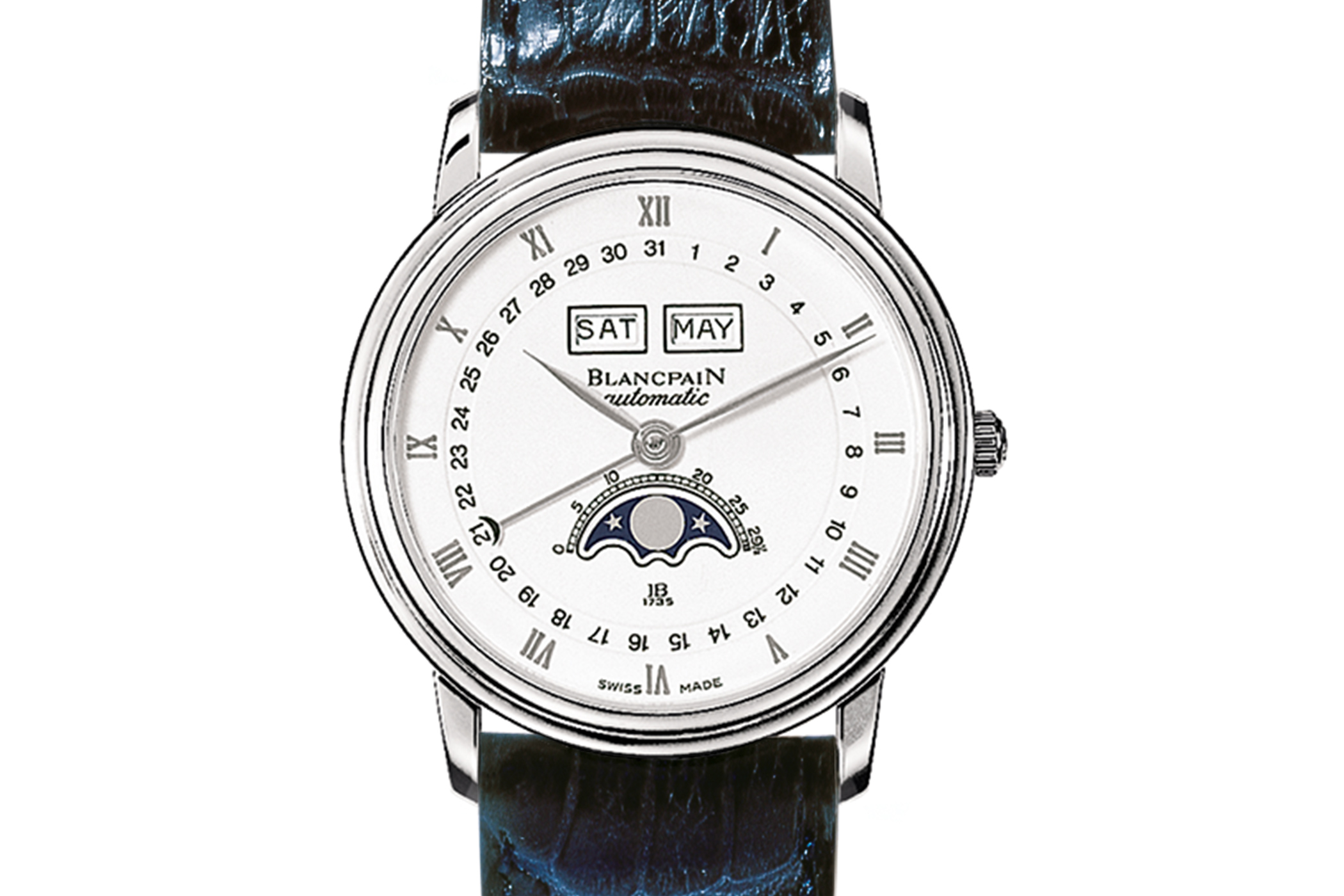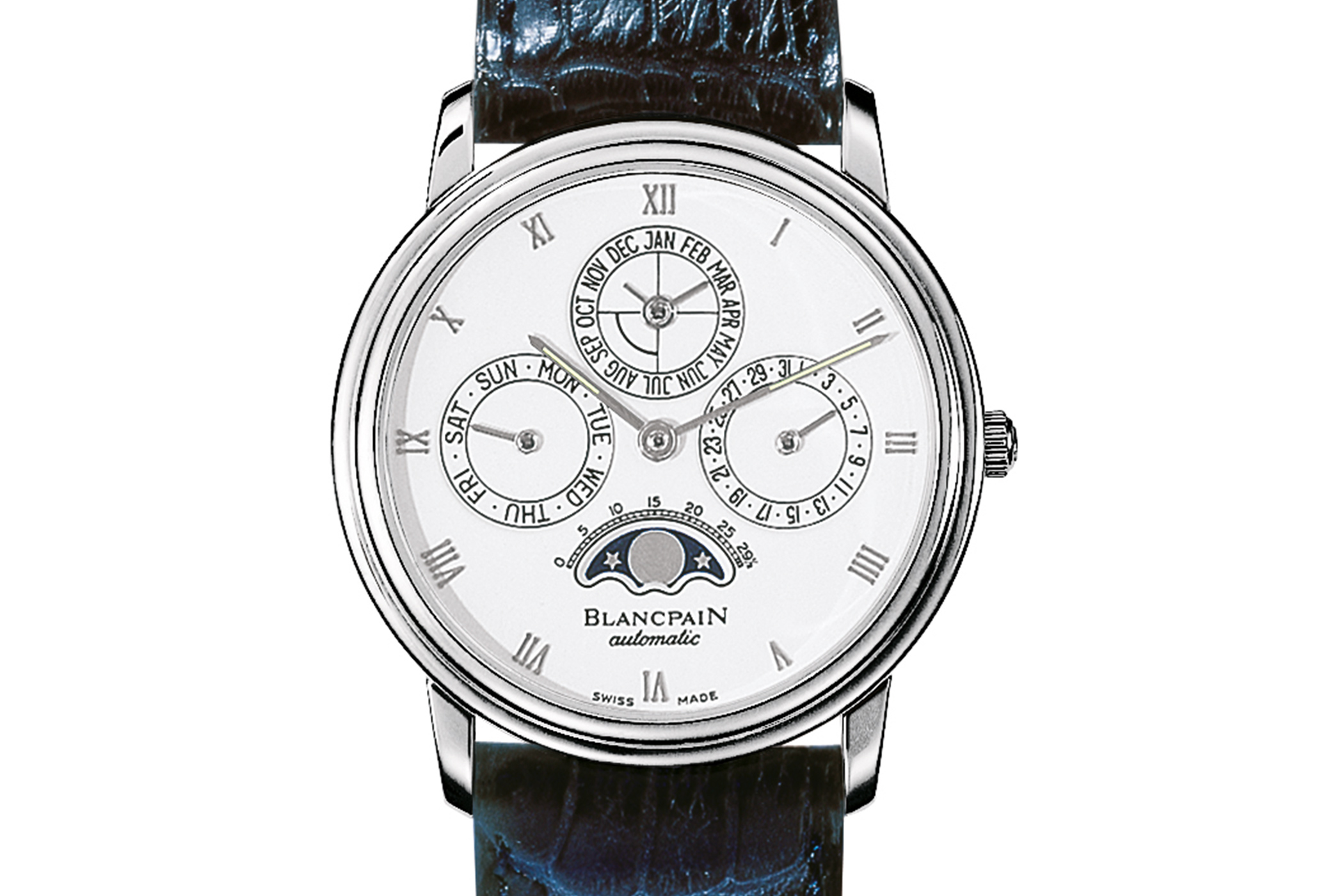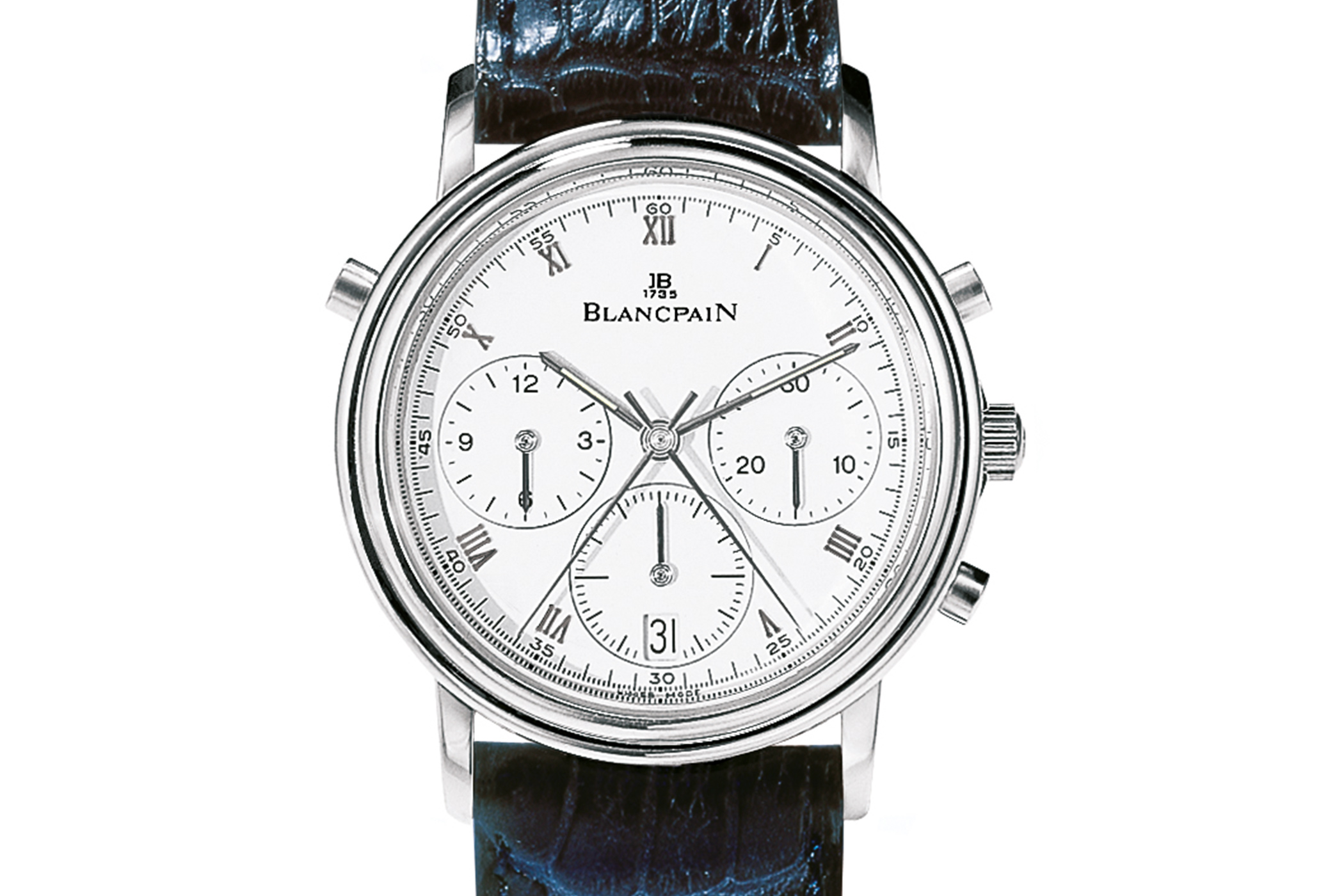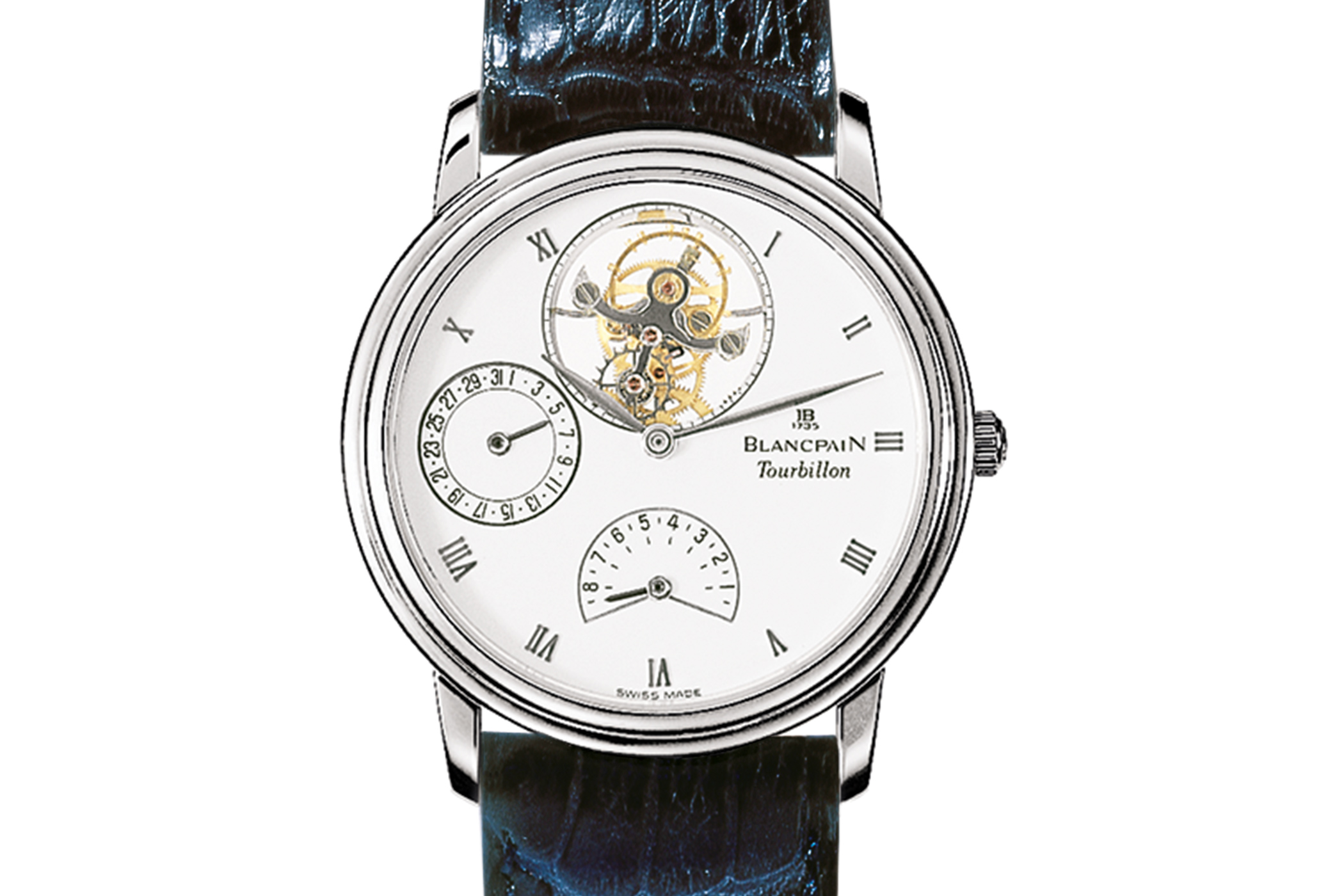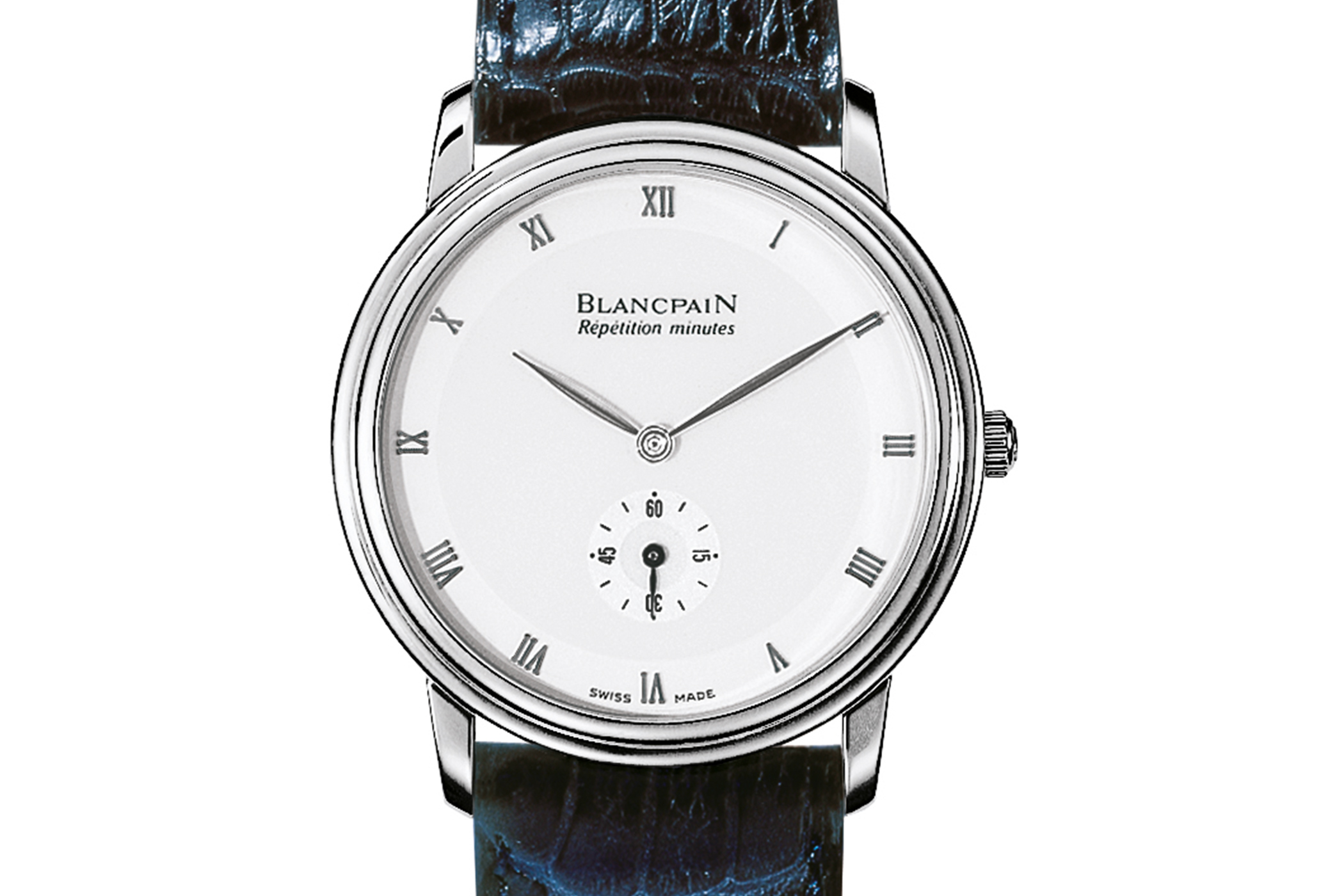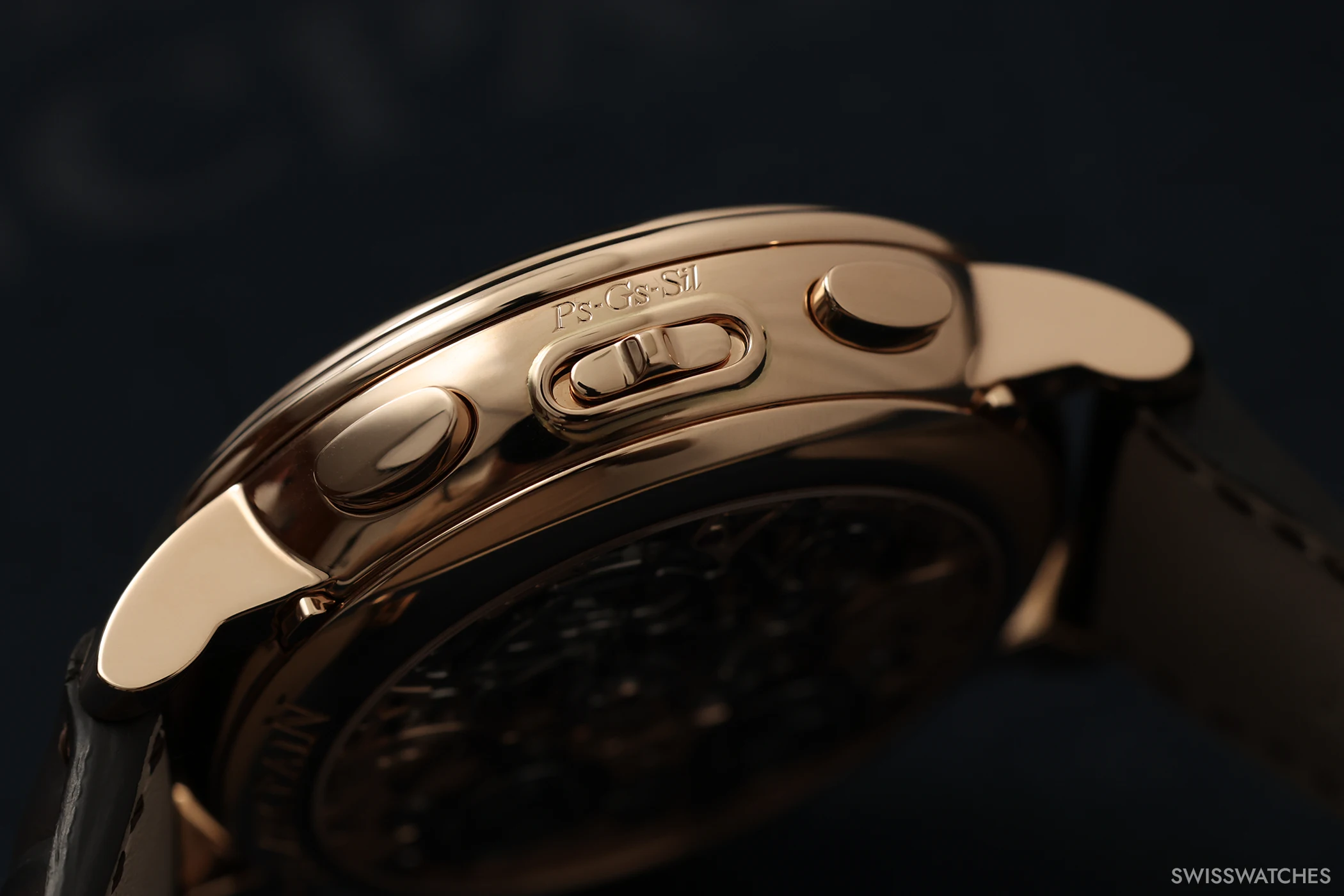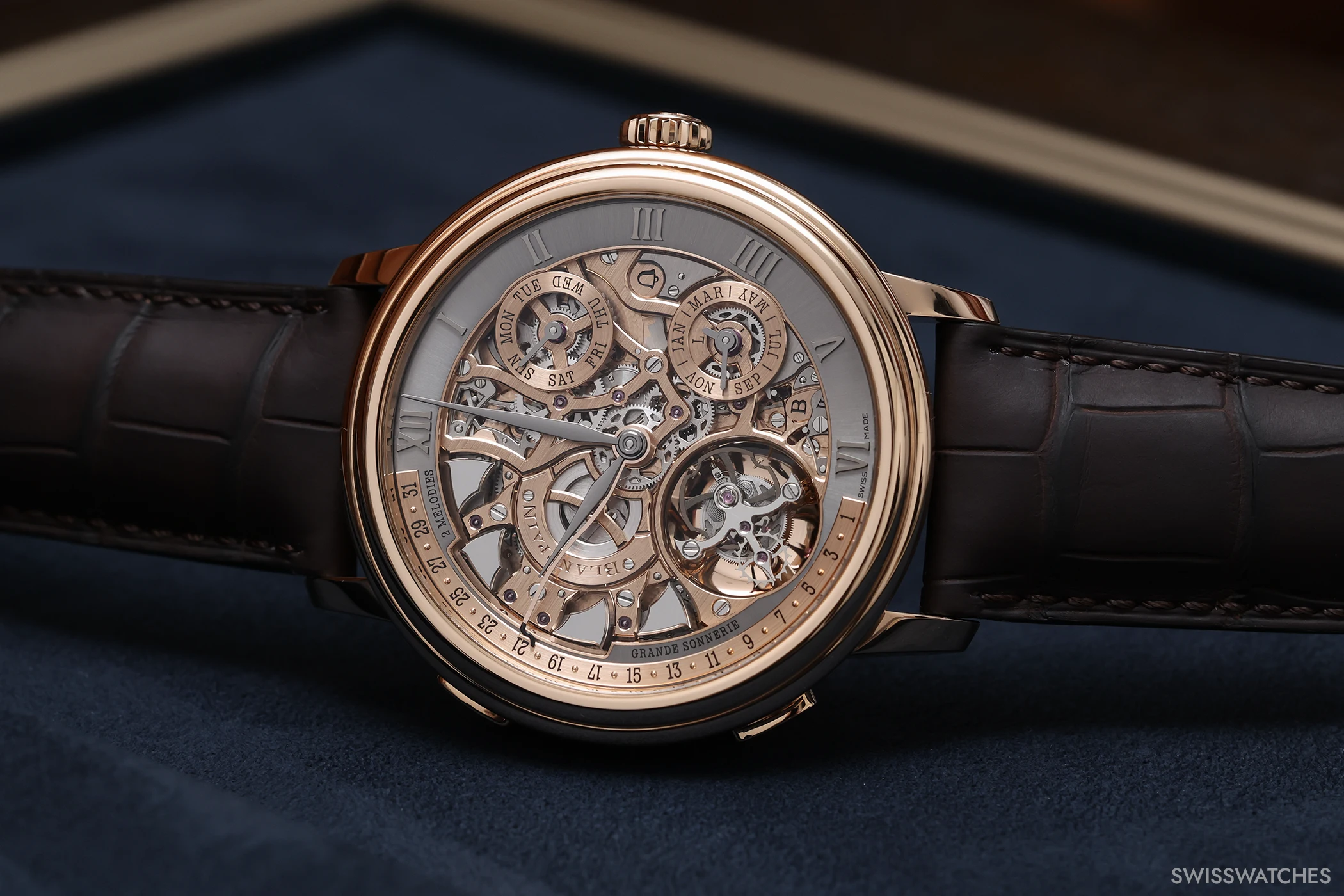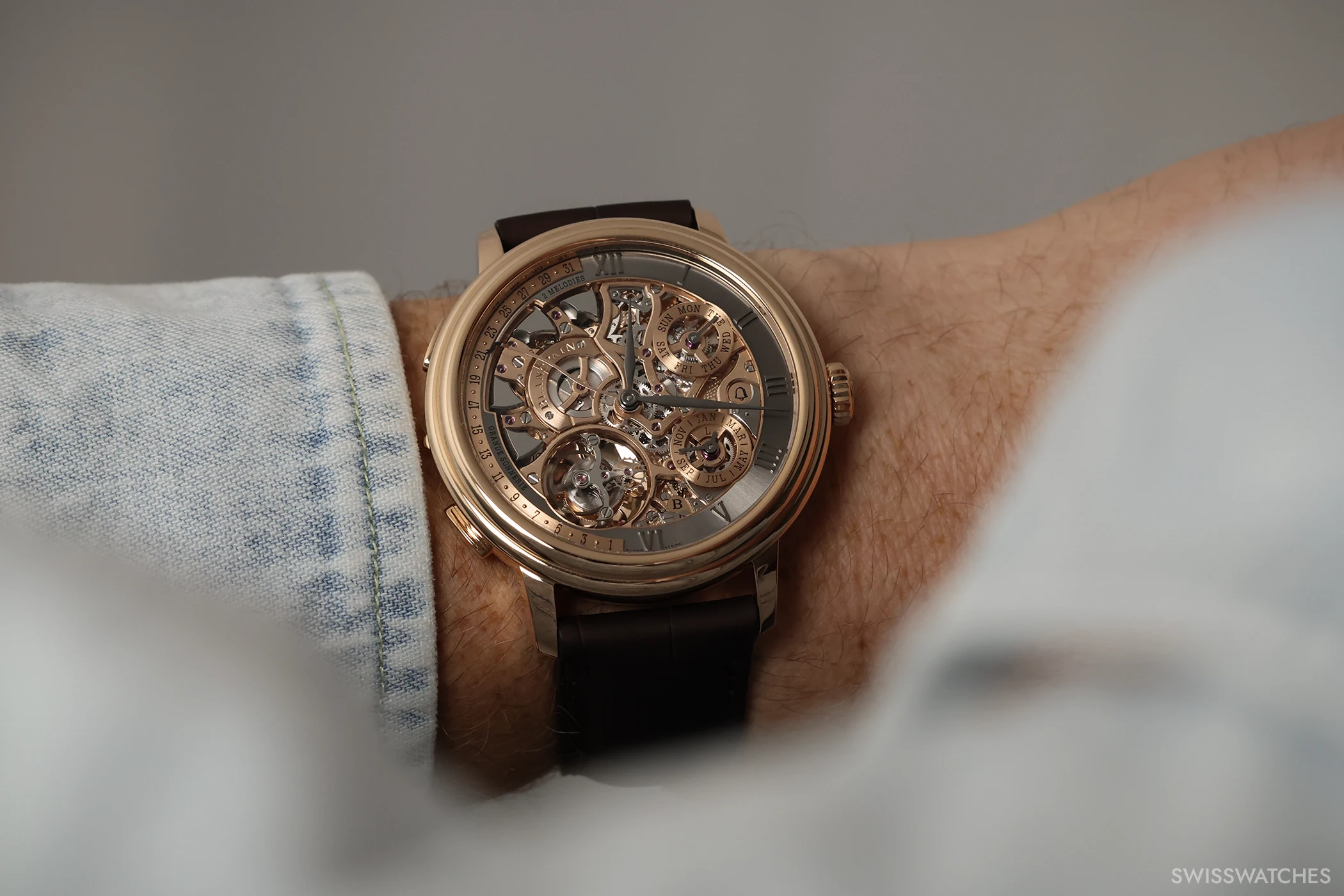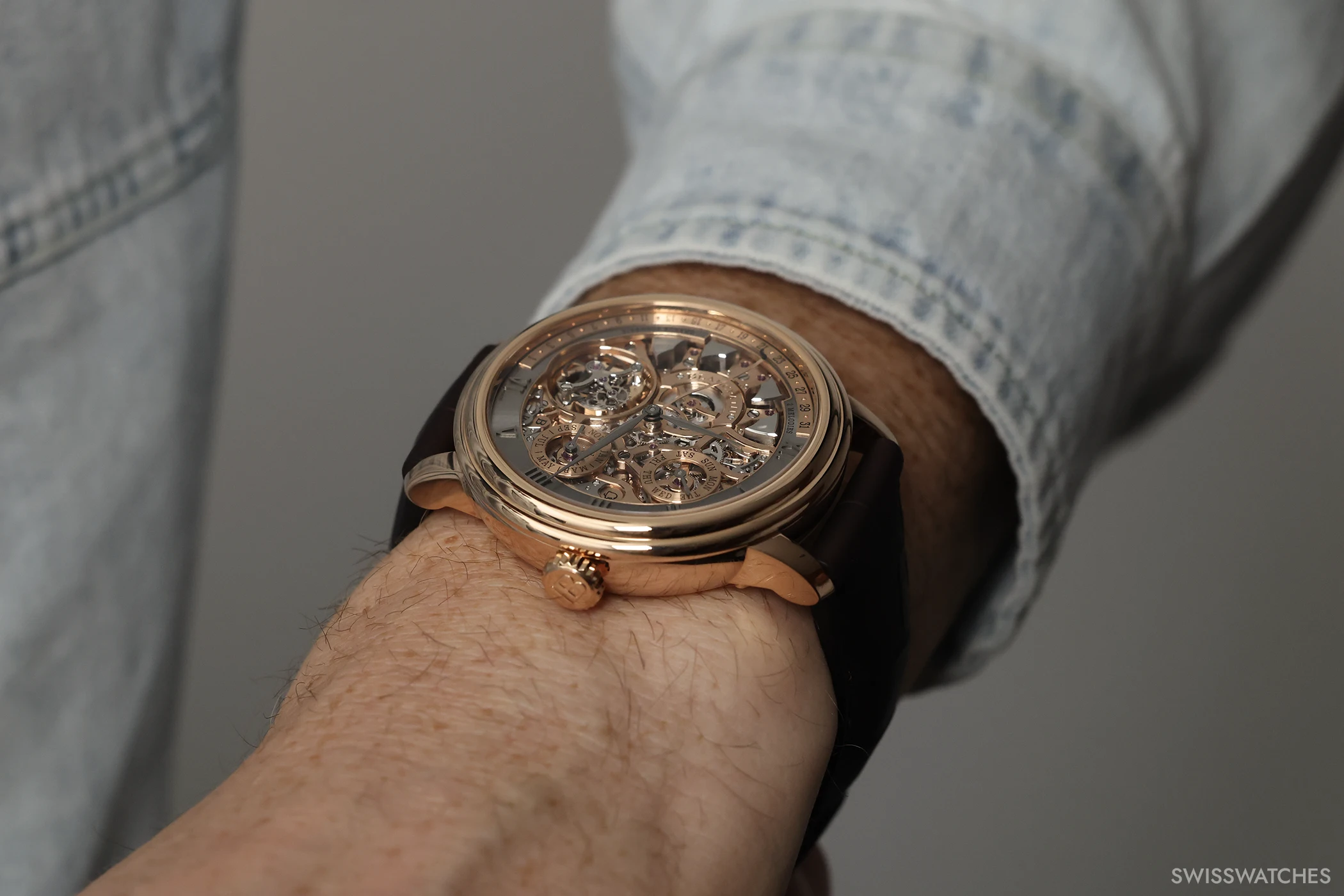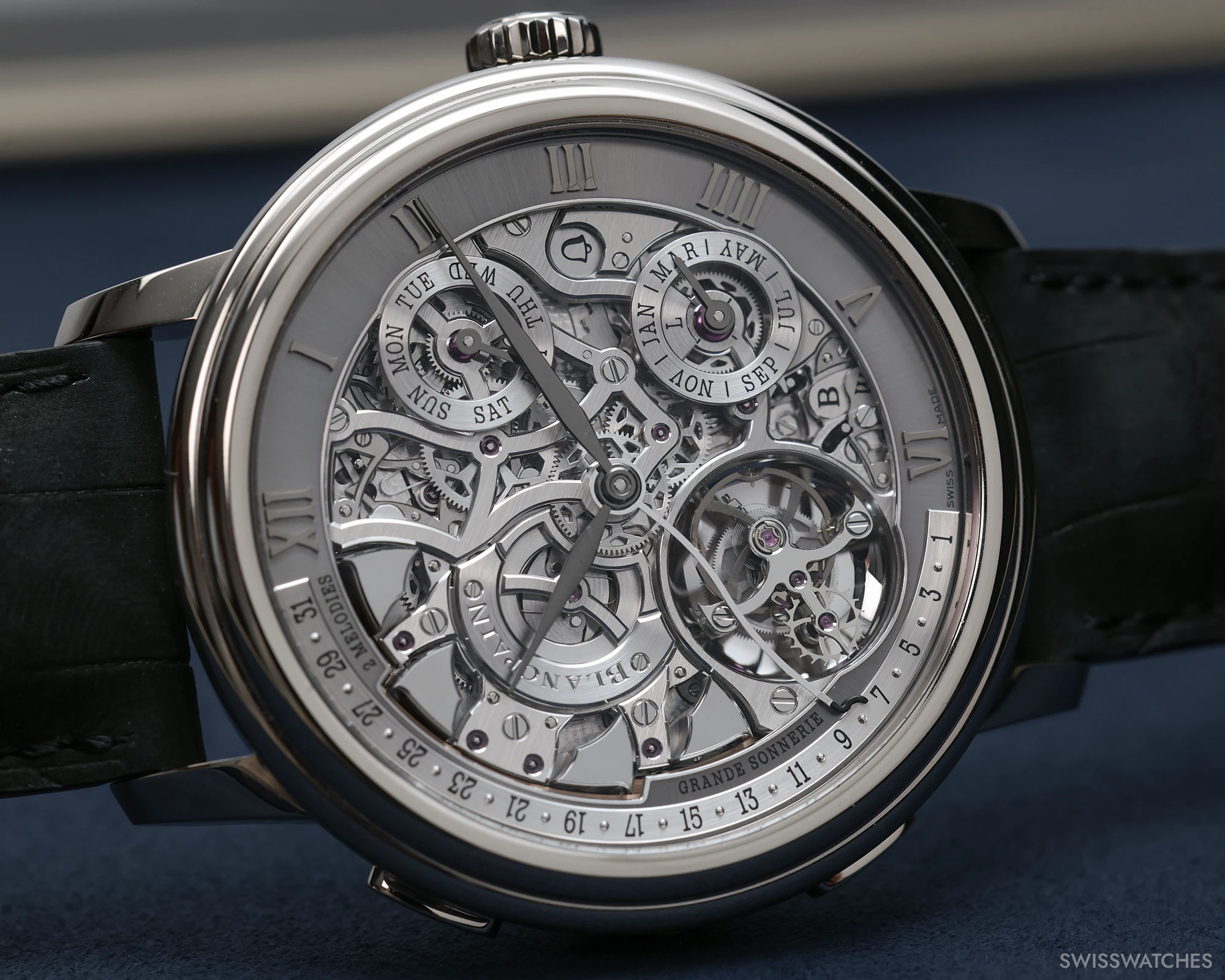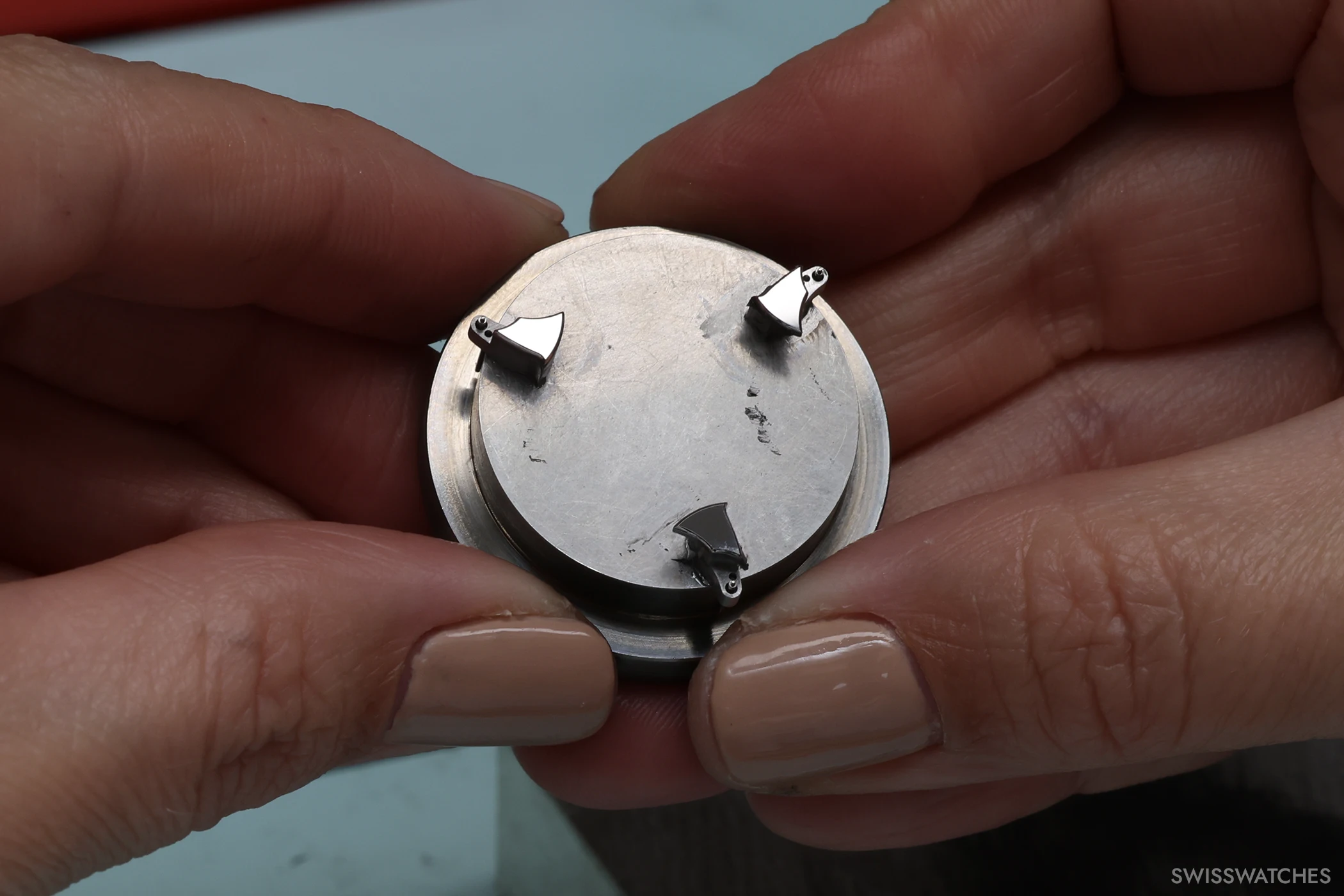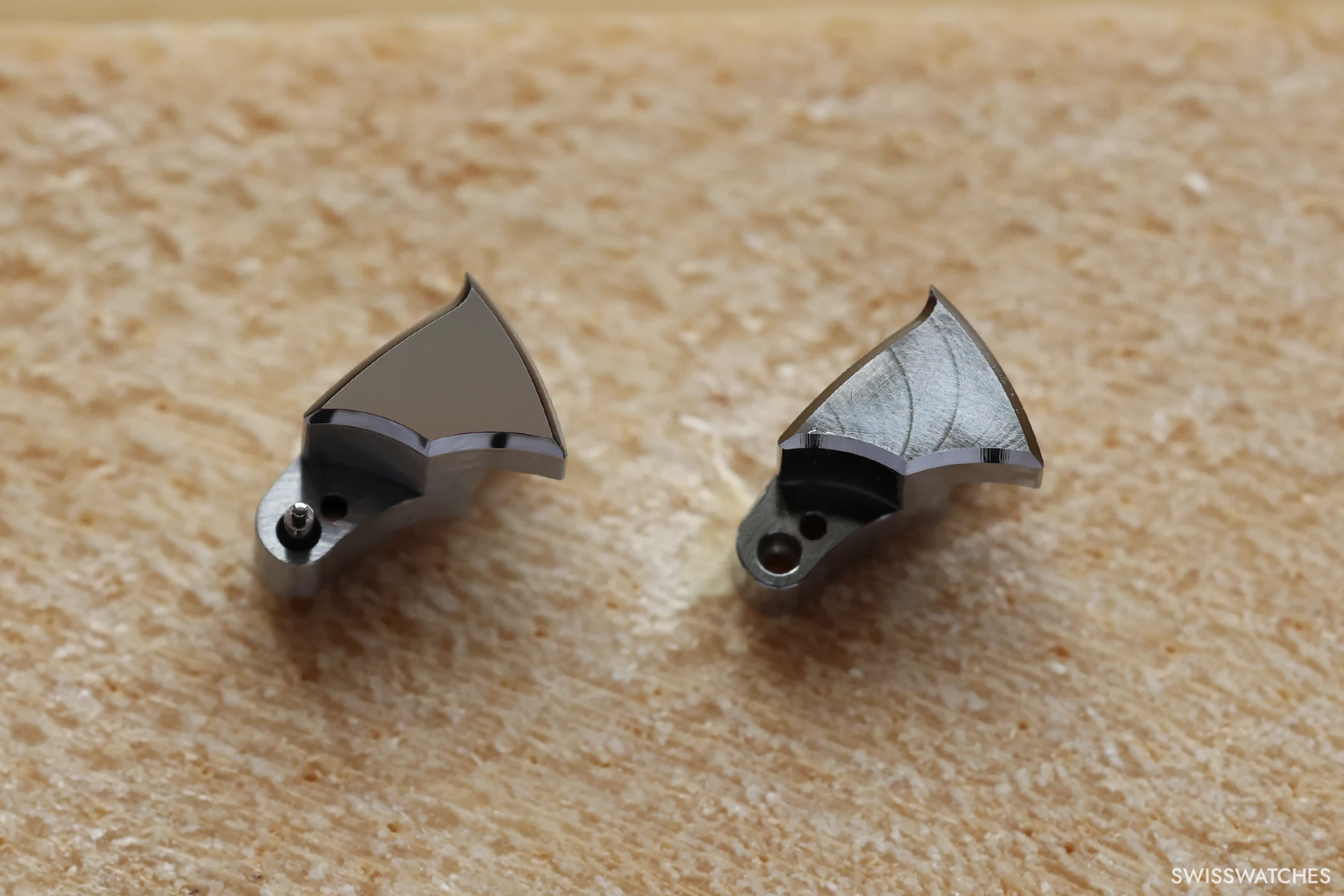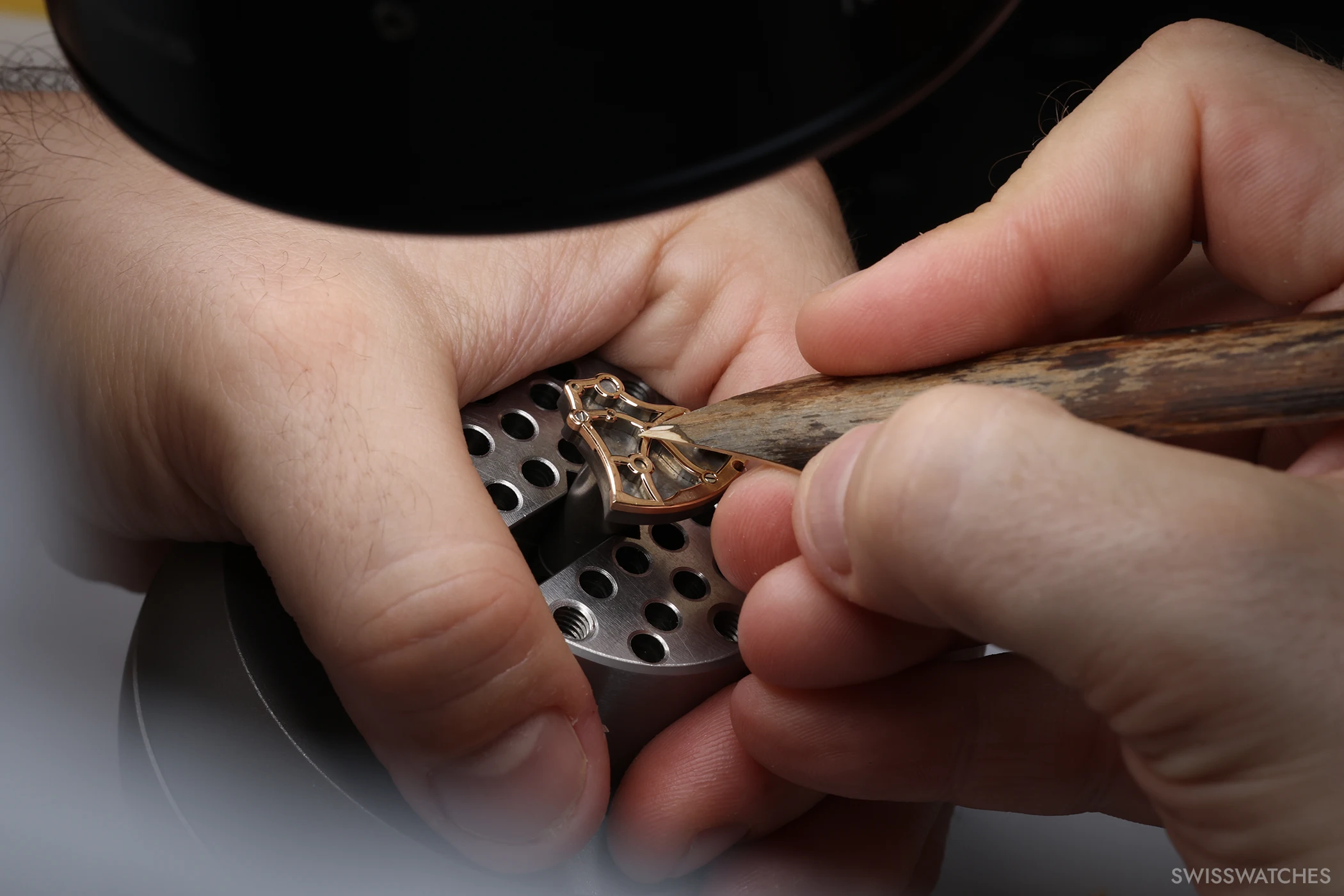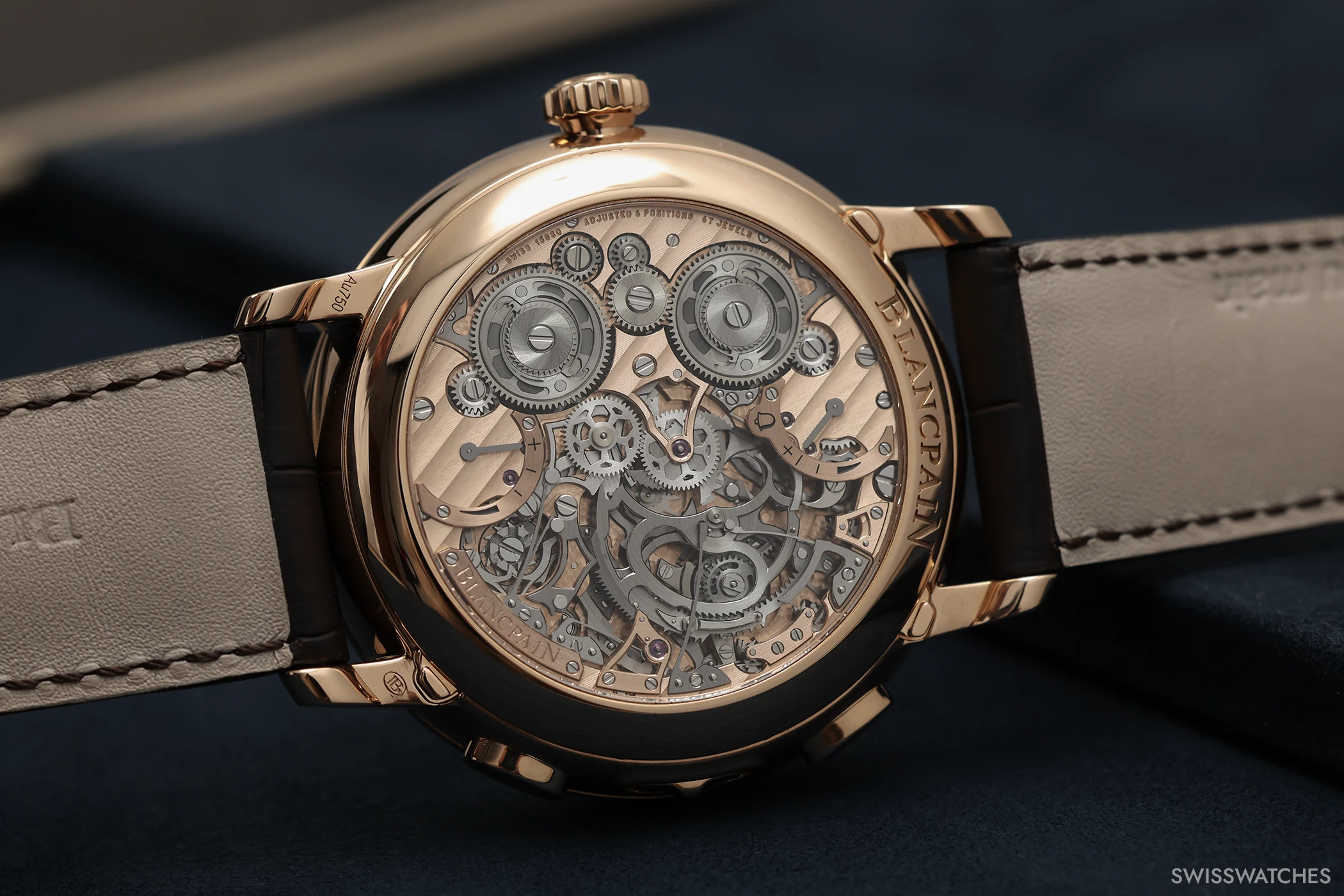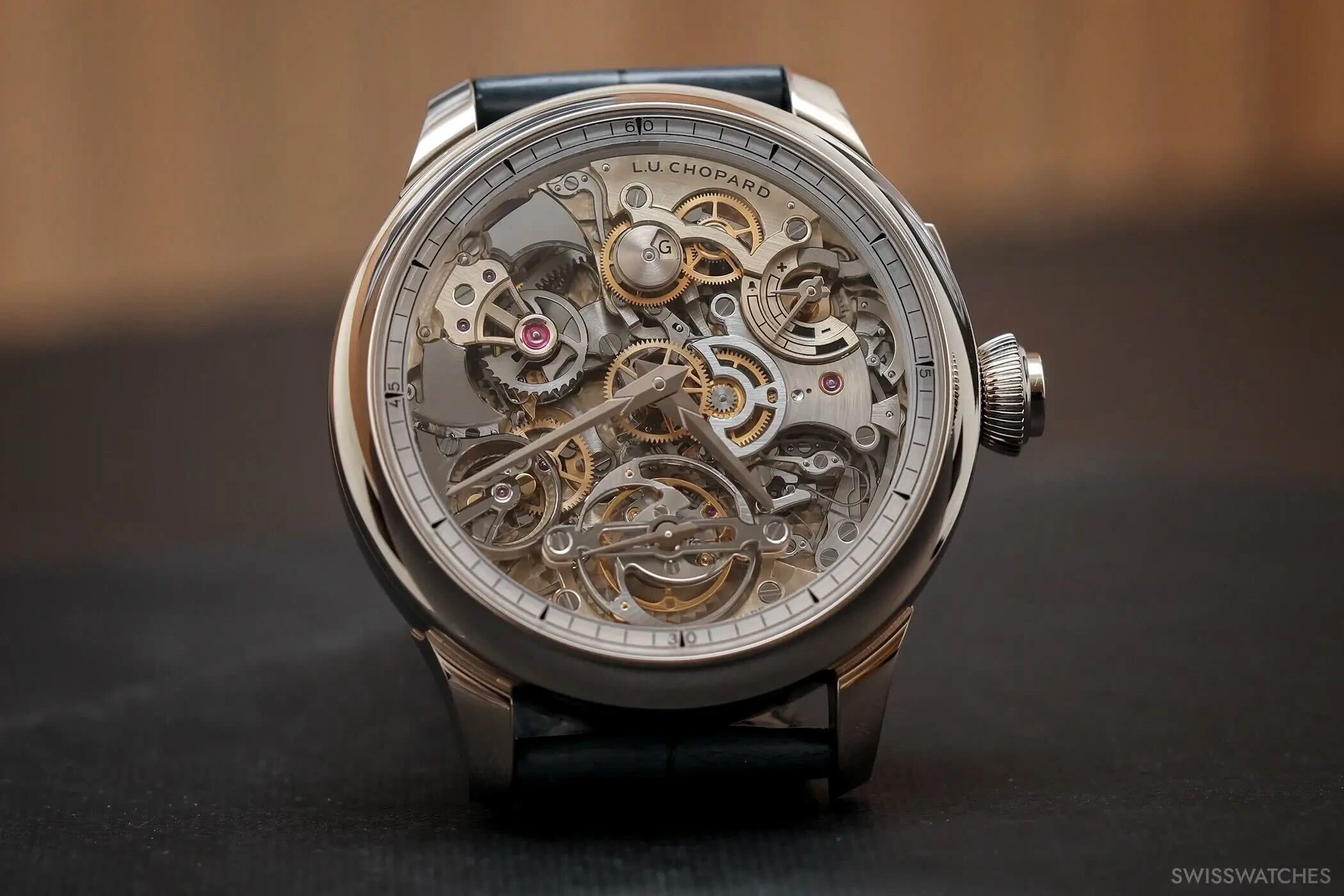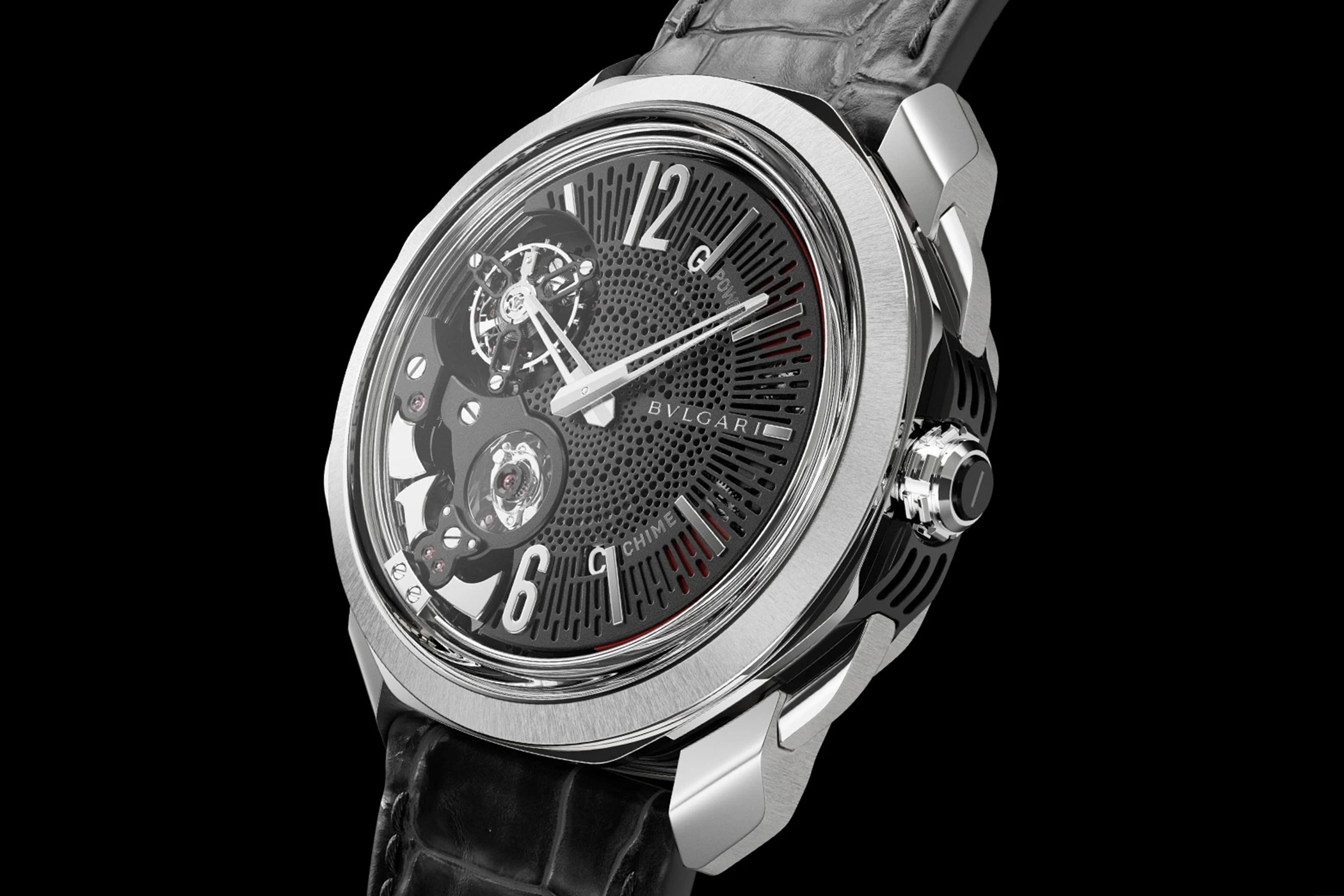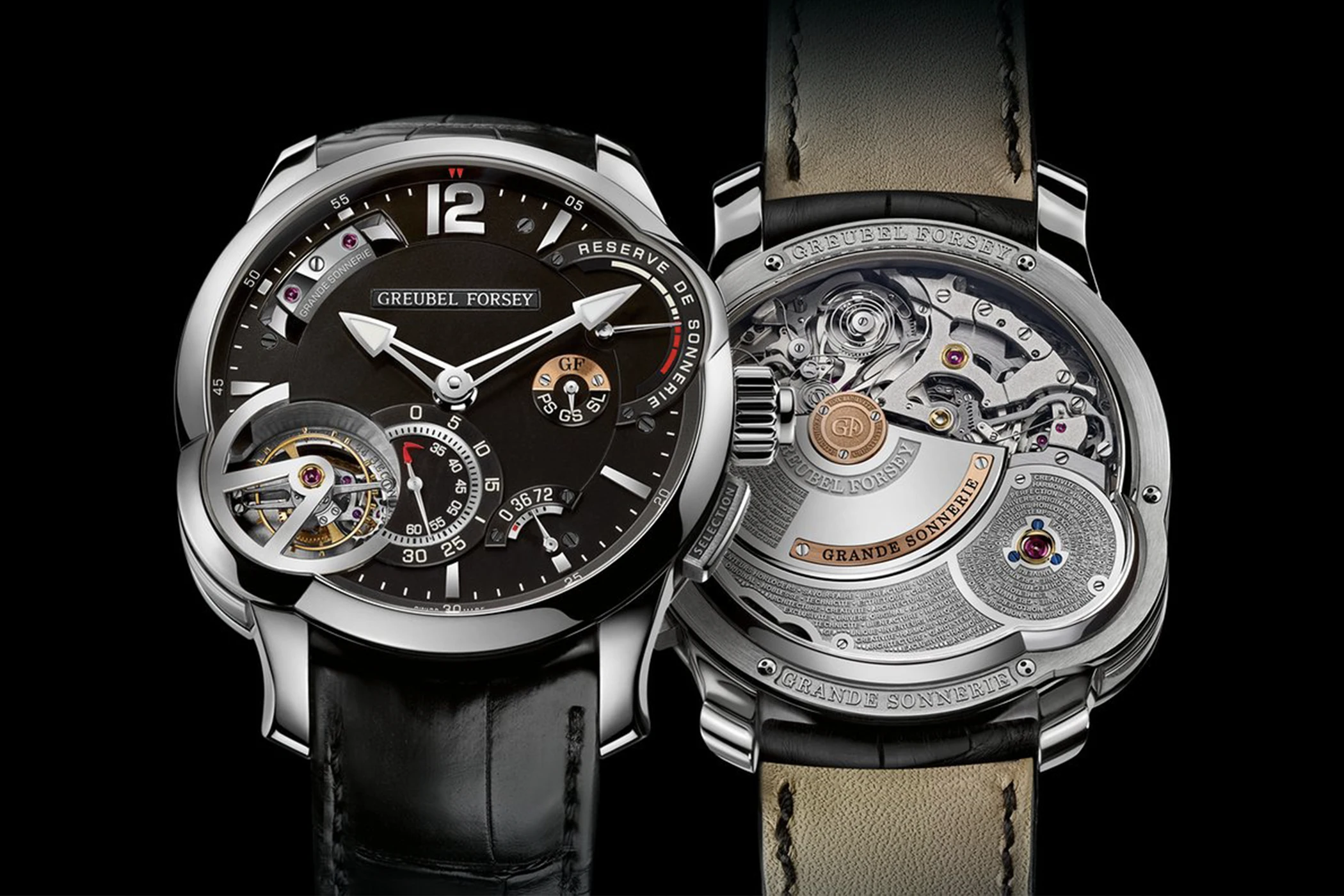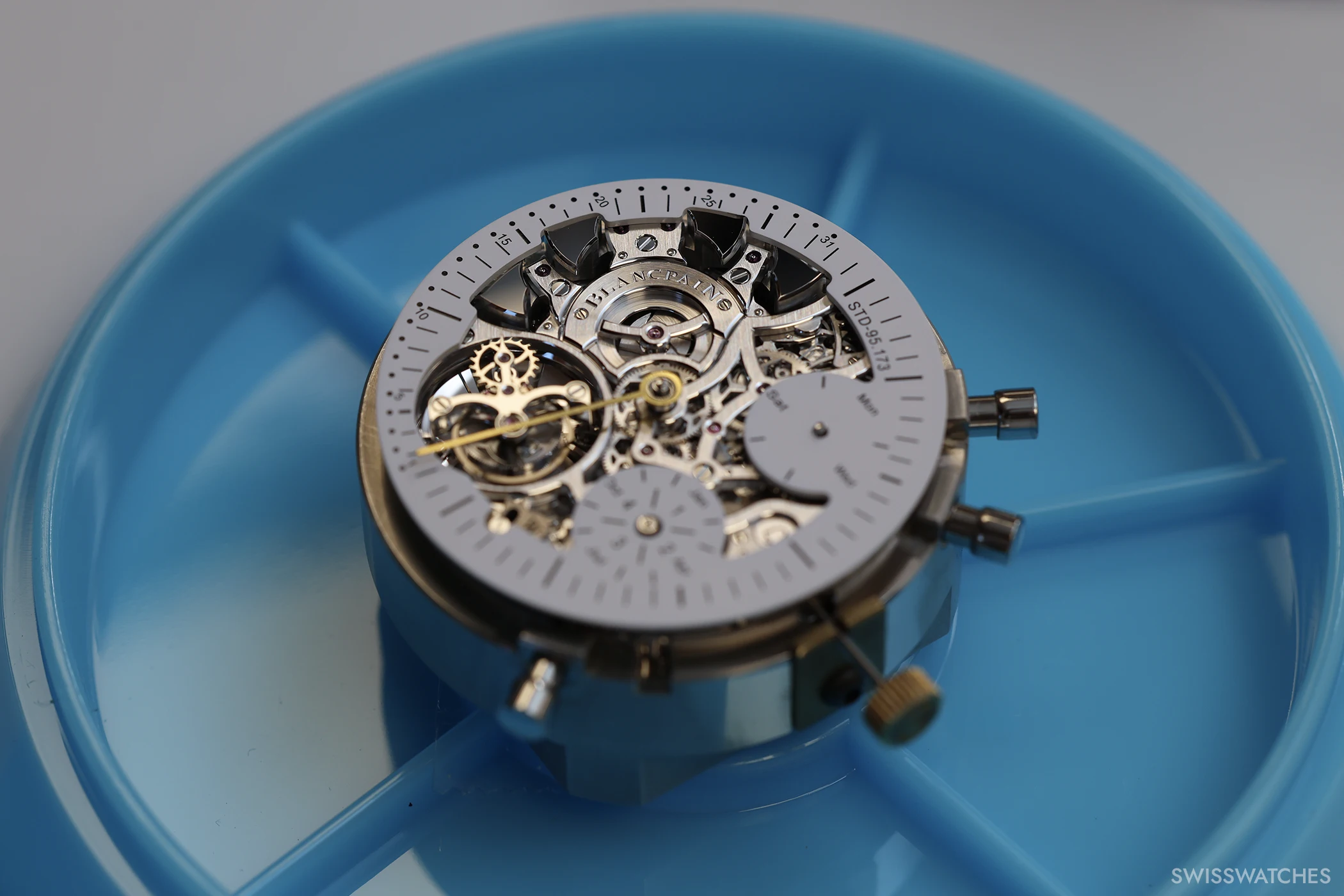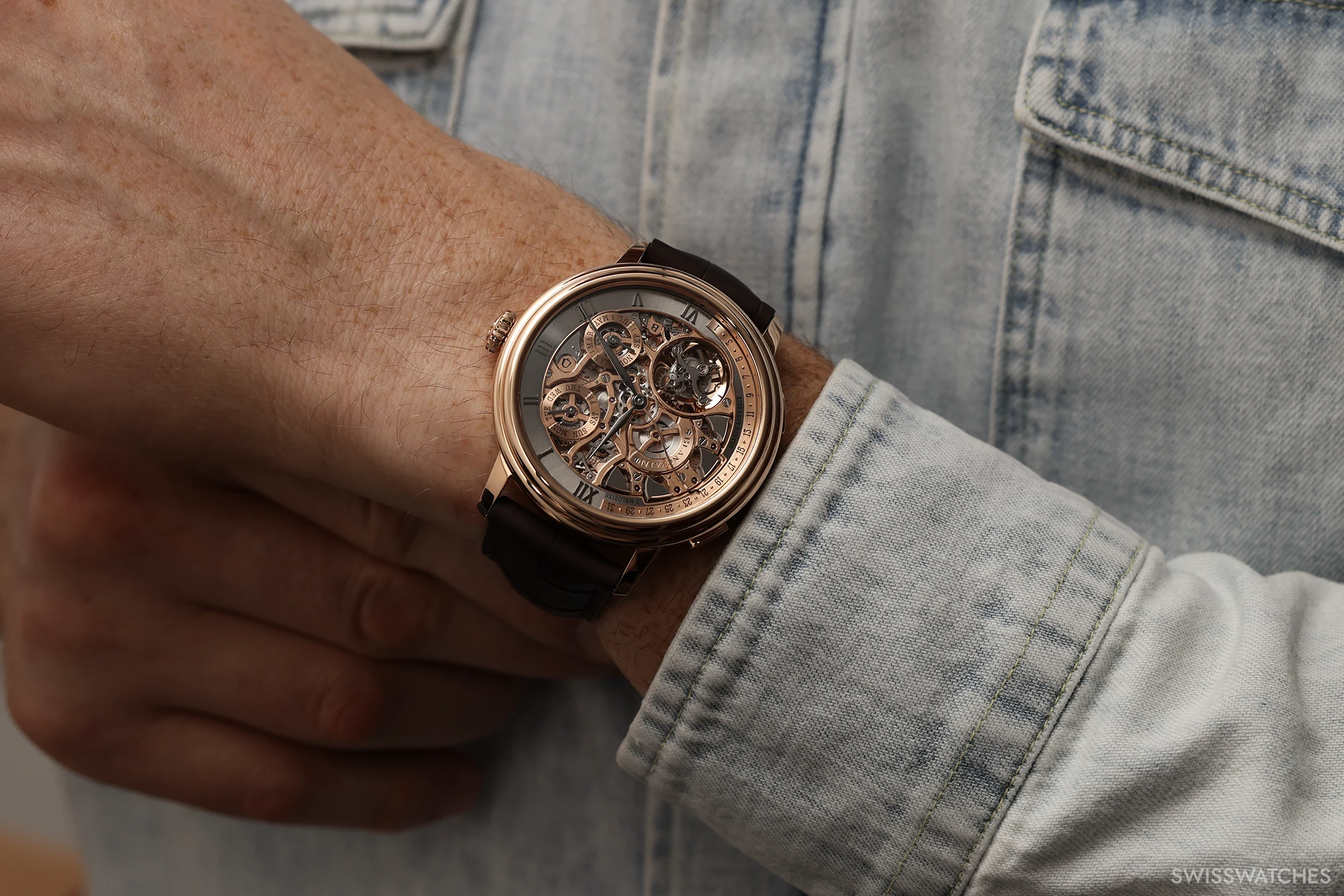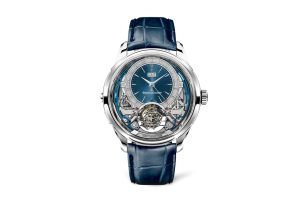

Blancpain Grande Double Sonnerie: Striking Mechanism with Two Melodies
Blancpain is presenting its most complicated wristwatch yet: an innovative and spectacular grand complication featuring a perpetual calendar, a tourbillon, and a grande sonnerie. A unique feature is that the wearer can select one of two melodies using a slide.
Following eight years of development, Blancpain has unveiled its most intricate timepiece to date: the Grande Double Sonnerie, which comprises over 1,000 movement components and boasts 13 patents. Assembly alone takes a whole year. As only two watchmakers are responsible for assembling and adjusting each watch from start to finish, only two pieces are manufactured each year. Chime watches, such as minute repeaters, are considered particularly challenging to produce among the grand complications, which also include the perpetual calendar and the tourbillon. The Grande Sonnerie, which strikes the time automatically every quarter of an hour, is even more complex. Only a few manufacturers have mastered this art, which we will discuss later.
The absolute pinnacle of craftsmanship is a watch with a Westminster chime, a melody named after the clock tower of the Palace of Westminster in London, commonly known as Big Ben, which plays it. To achieve this, four different gongs and hammers are required – twice as many as usual. Furthermore, the sequence of notes differs for each of the four quarter hours, further increasing the complexity. Not only has Blancpain created a wristwatch with a Westminster chime, but the Grande Double Sonnerie is also the world’s first wristwatch that can switch to a second melody for the quarter hours via a slide.
Alongside the grande Sonnerie, petite Sonnerie, minute repeater, and melody switching, this new model features a perpetual calendar, a tourbillon, and a skeletonised design. Blancpain has also succeeded in housing this mechanical masterpiece in a comparatively compact case.
History
Blancpain’s history dates back to 1735, when Jehan-Jacques Blancpain founded his watchmaking workshop in Villeret. As early as 1815, the manufacture was designing particularly slim movements, a speciality that endures to this day. In 1930, the brand unveiled the Rolls ladies’ watch, the smallest self-winding watch ever made. This was followed in 1956 by the Ladybird, fitted with what was then the smallest round movement in the world.
In the 1980s, Blancpain was among the first brands to usher in the renaissance of mechanical watchmaking after the quartz crisis, coining the slogan: ‘Since 1735, Blancpain has never made a quartz watch. It never will.’ This philosophy was reflected in six classic models that celebrated the art of watchmaking: an ultra-thin movement, a complete calendar with moon phase, a perpetual calendar, a split-seconds chronograph, a tourbillon, and a minute repeater.
The highlight was the Blancpain 1735, which combined all six complications in a single watch. With 740 components, it was the world’s most complicated wristwatch at the time. Since then, the brand has produced numerous other complicated timepieces, such as the Carrousel, which is similar to a tourbillon, and has paired it with other complications. One example is the Carrousel Répétition Minutes Chronographe Flyback.
The New Model’s Striking Mechanism
The highlight of the new Grande Double Sonnerie is undoubtedly its innovative striking mechanism. First, the wearer uses a slide to select petite sonnerie (Ps), grande sonnerie (Gs) or silence (Sil). Unlike some other sonnerie watches, the Blancpain strikes the hours and quarters on the hour in both grande and petite sonnerie modes.
World Premiere: Two Melodies
The true world-first feature is this: the lower pusher allows the wearer to choose between two melodies – the classic Westminster chime and a melody specially composed by KISS rock legend Eric Singer, aptly named ‘Blancpain’.
Between five and six o’clock, a B or W indicates which melody has been selected. The switching mechanism uses two superimposed racks for the quarter-hour strikes. Each rack has small teeth that activate the four hammers for the different notes. As the teeth on the two racks are arranged differently, each rack produces a distinct sequence of tones. The pusher moves a cam wheel that changes the vertical position of the double rack, bringing either the upper or lower rack into operation.
Sound of the Blancpain Grande Double Sonnerie
A four-note melody demands not only far greater mechanical effort but also more precision and fine adjustment than the two-tone chime of an ordinary minute repeater: the human ear is extremely sensitive to differences in tempo and pitch and immediately detects any inconsistency. The four notes of the Grande Double Sonnerie are E, G, F and B. Blancpain therefore makes the gongs from gold, achieving better acoustic performance than with the usual special steel alloys.
To achieve a steady striking rhythm, a fly governor or centrifugal brake is usually employed, as these components rotate quickly and provide stronger braking as speed increases. However, these regulators are generally at least faintly audible and can interfere with the sound of the chimes. Therefore, Blancpain has developed and patented a new silent system comprising a magnetic regulator in which movable metal masses rotate within a magnetic field and are slowed down accordingly. The faster the regulator turns, the deeper the masses move into the magnetic field and the stronger the braking effect becomes.
Blancpain has also eliminated the pause between the hour and minute strikes in the minute repeater, which occurs when no quarter hours are struck, by means of a mechanical switching system. Another patent concerns a system that uses a movable acoustic membrane in the bezel to enhance the sound. This gold membrane, which is mounted on the crystal, amplifies the lower tones in particular, making them more pleasing to the ear. Blancpain also provides a resonance box made of spruce to further improve the acoustics; the wood used for it comes from the immediate surroundings of the Vallée de Joux.
Safety
Alongside acoustics, Blancpain has also optimised the safety of the delicate striking mechanism: five systems protect the movement from damage. While the watch is chiming, the crown is disengaged and the time cannot be set. Conversely, the sonnerie will not chime while the time is being adjusted. A crossed-out bell symbol on the dial indicates this. The same symbol appears when the striking-work barrel no longer contains sufficient energy for the hour strike; in this case, chiming is likewise disabled.
Another safety mechanism ensures that the melody selector pusher cannot be operated while the watch is striking. The final system prevents the sonnerie from striking while the melody pusher is pressed. This ensures that the striking mechanism remains protected, even in the event of careless handling.
The Perpetual Calendar
The Grande Double Sonnerie boasts special features and innovations in more than just its chiming mechanism: the tourbillon and perpetual calendar both incorporate newly developed mechanisms, some of which are patented. In order to keep the calibre 15GSQ as slim as possible, the engineers integrated all complications directly into the movement. The perpetual calendar, with its retrograde date display, is located on the crown side. This retrograde date feature is particularly advantageous for the perpetual calendar, as it eliminates the need to advance the date by four days in February. Two patents have been filed for the perpetual calendar.
The date changes in just 20 milliseconds – so quickly that it is impossible for the human eye to detect the movement. To prevent damage, watchmakers have devised a shock-protection system for the hands. Corrector pushers for the calendar indications (date, day of the week, and month) are located under the lugs, enabling the wearer to operate them without tools. These pushers are not integrated into the case, but are housed within the movement together with their springs.
The engineers also developed a safety system for the perpetual calendar to prevent the owner from adjusting it while the date is in the process of changing, thus safeguarding the mechanism. Buyers can also choose the language used for the day and month displays, as well as the colour of the calendar indications.
The Tourbillon
The large tourbillon is positioned at seven o’clock. It oscillates at an unusually high four hertz, or 28,800 vibrations per hour, which improves accuracy. The watchmakers designed the tourbillon as a flying construction: it is supported only from the back, requiring no bridge on the dialside, which allows it to be viewed more clearly. The balance spring is made of silicon, meaning magnetic fields have no influence on it and cannot affect timekeeping accuracy.
Finishing of the Blancpain Grande Double Sonnerie
In total, the new calibre 15GSQ consists of an impressive 1,053 components. Blancpain has designed, produced, decorated, and assembled every single part entirely in its own workshops. For the 26 bridges and the mainplate, the brand has chosen 18-carat gold. Because of the elegant yet soft material, the watchmakers and finishers must work with even greater care and precision.
The skeletonised construction, which provides a deep insight into the complex mechanics, increases the amount of finishing required by up to fivefold. This is because, in addition to the outer edges, watchmakers must also bevel and polish the inner edges. The skeletonised calibre contains no fewer than 135 such angles. Traditional finishing includes anglage, perlage, mirror polishing, and diamond and straight graining. Visible and concealed surfaces are both artfully decorated by hand.
It takes each of the two master watchmakers, who have been specifically trained for this model, a full year to complete the decoration and assembly. At the end, the responsible master engraves his signature by hand on the back of the gold Blancpain plaque and installs it as the final step.
Grande Sonneries by Other Brands
While several manufactures now make minute repeaters, the far more complex grande sonnerie remains a genuinely rare complication. Philippe Dufour produced the first wristwatch with a grande sonnerie only in 1992. He was followed by F.P. Journe, Audemars Piguet, Franck Muller, Jaeger-LeCoultre, Patek Philippe, Vacheron Constantin, Bulgari, Greubel Forsey, and now Chopard. At present, only five other brands besides Blancpain offer watches with this additional feature.
The latest addition comes from Chopard and was recently unveiled as the brand’s first grande sonnerie. The L.U.C Grand Strike strikes the hours and quarter hours on two sapphire gongs milled from a single block of crystal. The movement comprises 686 parts, including the striking mechanism and integrated tourbillon. Chopard has also dispensed with a solid dial, revealing as much of the mechanism as possible. In addition to its powerful sound, the watch has been awarded a chronometer certificate – a rarity for striking watches.
To mark the manufacture’s 150th anniversary this year, Audemars Piguet also presented new variants of the Code 11.59 Grande Sonnerie Carillon Supersonnerie. The term ‘carillon’ refers to the fact that the watch strikes the quarter hours using three gongs (high, medium, and low). Introduced in 2015, Audemars Piguet’s Supersonnerie technology uses an additional soundboard with apertures and other innovations to produce a significantly amplified sound. As with previous models, the front of the watch is open to reveal the mechanics, while the hammers are concealed beneath the solid resonating plate.
In 2024, Bulgari introduced the Octo Roma Grande Sonnerie Tourbillon. Its special feature is that it strikes the quarter hours with a melody on four gongs tuned in tritone intervals, which are three whole tones apart, creating a deliberately tense dissonance. Three of the four hammers, the centrifugal governor, and a tourbillon are visible on the dial. The complex programme mechanism of the striking work is revealed on the caseback. The Bulgari movement consists of 754 parts.
In 2020, Patek Philippe presented what is perhaps the most understated grande sonnerie, the Reference 6301: on the enamel dial, only two small power-reserve indicators – alongside the hour and minute hands and small seconds – hint that this is no ordinary watch. Inside, more than 700 components are at work. Derived from the Grandmaster Chime, the 6301 strikes on three gongs rather than two. Patek Philippe did indulge in one small additional complication: the small seconds is executed as a seconde morte, jumping forward once per second.
Greubel Forsey presented its most complex model to date in 2017: the Grande Sonnerie. After eleven years of research and development, the manufacture created its striking watch with tourbillon and 935 movement components. Unique to this model is the automatic winding system for the sonnerie barrel. Other special features include a titanium acoustic resonance chamber, eleven safety mechanisms and a water-resistant case.
Final Thoughts
Blancpain’s achievement is remarkable: an entirely new grande sonnerie in which, for the first time in wristwatch history, the wearer can choose between two melodies. Numerous patents and innovations enhance safety, sound quality, and usability. The perpetual calendar and tourbillon have also been further refined.
Thanks to the skeletonised construction, the four hammers and large parts of the fascinating mechanism can be observed in action. This significantly increased the effort required for the elaborate hand-finishing. Finally, as a specialist in ultra-thin watches, Blancpain succeeded in fitting over 1,000 components into a wearable case: all complications are housed in a watch measuring 47 millimetres in diameter and just 14.5 millimetres in height.
The Grande Double Sonnerie is available in white gold or red gold and is priced at 1.7 million Swiss francs, including taxes if purchased in Switzerland.
